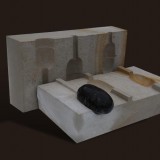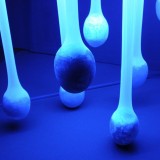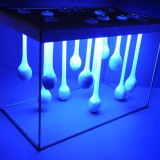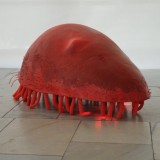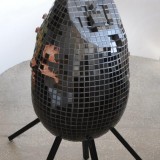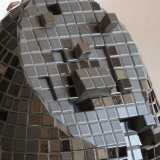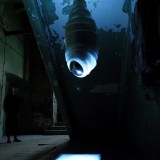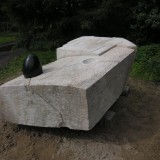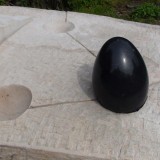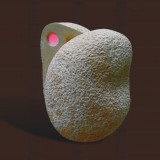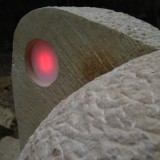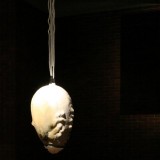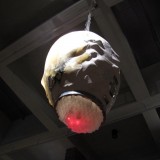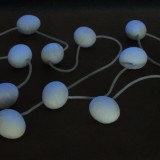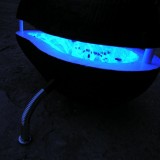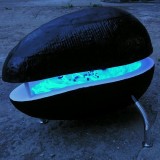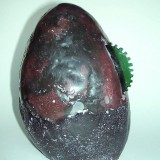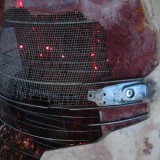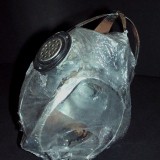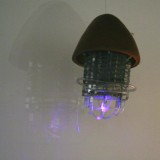Agnieszka Miko³ajczyk
Born in 1979 in £ód¼. In 2005 she graduated from the Sculpture Studio of the Academy of Fine Arts in £ód¼, Department of the Visual Education (currently of Visual Arts). Since 2007 she has worked as an assistant professor in this studio and she also makes films for the SE-MA-FOR film production company. Agnieszka Miko³ajczyk develops her art in the areas of sculpture, installation and site-specific works. She participates in exhibitions and sculpture symposia, for example in the Center for Polish Sculpture in Orońsko, the International Sculpture Symposium “Landek” in Ostrava (Czech Republic 2010), the First International Sculpture Symposium “Angelo Zanelli” (Primo Simposio Internazionale di Scultura “Angelo Zanelli”) in Rezzato (Italy 2011) and in the exhibition “Mutual interactions / Wechselwirkungen” in the Flottmann-Hallen Gallery in Herne (Germany 2009) amongst others.
Agnieszka Miko³ajczyk’s art is related to themes concerning the contemporary development of technology and its branches associated with biology, biotechnology and genetic engineering. The artist reflects upon the influence of scientific interference into the genetic code and the development of living organisms. She comments upon her art as follows:
My current art is dominated by the question of the modification of biological life, a contemporary phenomenon mutually intermingling the biological and technological elements. Modern technologies of the 21st century which develop their activities very fast (robotics, genetic engineering and nanotechnology) plus activities dealing with cloning, implanting and modifying living organisms. In my understanding this calls new forms into being, equipped with electronic replacements of biological organs. This mixture of organic, soft and viscous tissue with the artificial, cold and synthetic creation in one organism, stimulates my imagination and ceaselessly inspires me. The fruit of this, in my present art, id the development of hybrid forms that are a conglomerate of these two elements: biological and technological objects which show attributes of life. They are a visual metaphor of this symbiosis of elements, which is taking place in the contemporary world.
The works of Agnieszka Miko³ajczyk do not negate and do not value the phenomena occurring. The artists is fascinated by the evolution of the forms of life that are currently taking place on Earth. As a result of the development of science and technology, man is interfering more and more in the natural environment, leading to the possibility of the modification of living organisms via DNA change or cloning.
The artist in her works uses contemporarily plastics available (polyester and epoxy resin, polyurethane foam, silicone), and in addition also makes her work in stone. Traditional sculpture workshop techniques connect with multimedia elements – for example the use of sound or light. These elements showed up for the first time in the artists diploma work entitled Bio-tech-object (2005). An installation of a few-meters in size consisting of a series of sculptural objects, which refer by their shape to an egg. In the central place of the arranged setting, a two-meter object in the form of a giant egg was placed, from which came organic sounds (flowing liquids, heart beating, pulse). The object had a variety of textures, in some parts semi-transparent, so that we could look inside. Its interior was a complex water installation, wrapped around a net built of pulsing red diodes. The remaining, much smaller sculptural objects which were revolving around the large one like satellites were subsequent variations of a sculptural response to the bio-technical beings.
During the sculpture symposium in Brastislava (2008) the artist made a oval object consisting of two halves which looked like dark shells. From a gap between them there shone UV light.
As part of “Dialogues with the Space” (in the Gallery for the Promotion of the Young, £ód¼ 2008) she used four rectangular shaped flowerbeds placed at an abandoned shopping hall in the neighbourhood called Ba³uty. The communist style building made according to the modernist model had fallen into total decay. On the flowerbed in place of flowers there was self-sown grass. The artist placed four intensely red shapes there, whose colour and shape contrasted with the dirty, grey space and the architecture based on straight angle. The sculptures on the flowerbeds looked like creatures which had appeared there from the another world. The colour of the sculptures was highlighted by the contrast with the green grass.
In the work Unpredictible stream she also referred to the local architecture. In the Italian town Rosora as part of artistic workshops entitled R.I.V.E.R, in a very narrow passage between houses made of stone, the artist placed two objects. Their organic, undefined form suggested a kind of liquid structure getting through the cracks of the buildings. The objects were placed above the heads of passers-by.
As part of the project I – Here and Now (2009) presented in an abandoned factory in £ód¼, she made a work entitled Lenticel. The title of the work refers to the opening in an air-tight outer layer of land organisms (animals and plants) making an exchange of gas possible. Lenticels are lumps which show up on a stem or root. The sculpture Lenticel is a blue and red shiny round object hung in the space, out of which stuck “rhizomes”. A shadow which showed up behind the sculpture, being a flat synthesis of its form, also became an element of the work.
A site-specific work in an abandoned factory in £ód¼ entitled Genetix (2010) emerged in a form of a strange cocoon hanging from the ceiling. Out of its white form, placed in a stream of light, appeared a metallic, oblong shape. Our imagination may suggest that from the cocoon, a monstrous larva would emerge.
In 2010/2011 the artist made a series entitled Clones. On white egg-shaped forms there were flesh-coloured dots. The almost identical egg-shaped forms were connected by a kind of a rope, which suggested an organic relationship between them. Another work from the same series was closed in a display cabinet lit by UV light. There were forms of similar shape suggesting possible associations with test-tubes, eggs, sperm or rhizomes. The shapes were hanging from the cabinet and had various size and length, so the viewer was under the impression that something was a breeding under laboratory conditions. The lower part of the semi-transparent objects was covered by a coarse texture.
The work entitled Shuttle (presented at the 5th International Katarzyna Kobro Sculpture Symposium of in the Centre for Polish Sculpture in Orońsko) was an object in the shape of a shuttle which referred to the history of £ód¼, famous for textiles. The work responded to the theme of this year’s symposium “£ÓD¬, from £ód¼” and the artist showed her high technical skills. The differences in the textures of the object suggest that the work was made by a merged technique, however in fact only marble was used.
The works by Agnieszka Miko³ajczyk evoke a strange anxiety. Live organisms usually bring associations with warmth, odour, tactile elements, even if these experiences sometimes also cause pleasurable sensations. The forms created by the artist are deprived of this kind of sensuality. She often uses UV light, which makes them appear even colder. Looking at some of her work, we are under the impression that we are visiting a laboratory in which new forms of life are bred in “unnatural conditions”. What might happen if they slip out of control?
Anka Le¶niak


